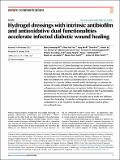| dc.contributor.author | Pranantyo, Dicky | |
| dc.contributor.author | Yeo, Chun Kiat | |
| dc.contributor.author | Wu, Yang | |
| dc.contributor.author | Fan, Chen | |
| dc.contributor.author | Xu, Xiaofei | |
| dc.contributor.author | Yip, Yun Sheng | |
| dc.contributor.author | Vos, Marcus Ivan Gerard | |
| dc.contributor.author | Mahadevegowda, Surendra H | |
| dc.contributor.author | Lim, Priscilla Lay Keng | |
| dc.contributor.author | Yang, Liang | |
| dc.contributor.author | Hammond, Paula T | |
| dc.contributor.author | Leavesley, David Ian | |
| dc.contributor.author | Tan, Nguan Soon | |
| dc.contributor.author | Chan-Park, Mary B | |
| dc.date.accessioned | 2025-07-16T17:21:38Z | |
| dc.date.available | 2025-07-16T17:21:38Z | |
| dc.date.issued | 2024-02-01 | |
| dc.identifier.uri | https://hdl.handle.net/1721.1/160562 | |
| dc.description.abstract | Chronic wounds are often infected with biofilm bacteria and characterized by high oxidative stress. Current dressings that promote chronic wound healing either require additional processes such as photothermal irradiation or leave behind gross amounts of undesirable residues. We report a dual-functionality hydrogel dressing with intrinsic antibiofilm and antioxidative properties that are synergistic and low-leaching. The hydrogel is a crosslinked network with tethered antibacterial cationic polyimidazolium and antioxidative N-acetylcysteine. In a murine diabetic wound model, the hydrogel accelerates the closure of wounds infected with methicillin-resistant Staphylococcus aureus or carbapenem-resistant Pseudomonas aeruginosa biofilm. Furthermore, a three-dimensional ex vivo human skin equivalent model shows that N-acetylcysteine promotes the keratinocyte differentiation and accelerates the re-epithelialization process. Our hydrogel dressing can be made into different formats for the healing of both flat and deep infected chronic wounds without contamination of the wound or needing other modalities such as photothermal irradiation. | en_US |
| dc.language.iso | en | |
| dc.publisher | Springer Science and Business Media LLC | en_US |
| dc.relation.isversionof | 10.1038/s41467-024-44968-y | en_US |
| dc.rights | Creative Commons Attribution | en_US |
| dc.rights.uri | https://creativecommons.org/licenses/by/4.0/ | en_US |
| dc.source | Springer Nature | en_US |
| dc.title | Hydrogel dressings with intrinsic antibiofilm and antioxidative dual functionalities accelerate infected diabetic wound healing | en_US |
| dc.type | Article | en_US |
| dc.identifier.citation | Pranantyo, D., Yeo, C.K., Wu, Y. et al. Hydrogel dressings with intrinsic antibiofilm and antioxidative dual functionalities accelerate infected diabetic wound healing. Nat Commun 15, 954 (2024). | en_US |
| dc.contributor.department | Singapore-MIT Alliance in Research and Technology (SMART) | en_US |
| dc.contributor.department | Massachusetts Institute of Technology. Department of Chemical Engineering | en_US |
| dc.relation.journal | Nature Communications | en_US |
| dc.eprint.version | Final published version | en_US |
| dc.type.uri | http://purl.org/eprint/type/JournalArticle | en_US |
| eprint.status | http://purl.org/eprint/status/PeerReviewed | en_US |
| dc.date.updated | 2025-07-16T17:11:27Z | |
| dspace.orderedauthors | Pranantyo, D; Yeo, CK; Wu, Y; Fan, C; Xu, X; Yip, YS; Vos, MIG; Mahadevegowda, SH; Lim, PLK; Yang, L; Hammond, PT; Leavesley, DI; Tan, NS; Chan-Park, MB | en_US |
| dspace.date.submission | 2025-07-16T17:11:29Z | |
| mit.journal.volume | 15 | en_US |
| mit.journal.issue | 1 | en_US |
| mit.license | PUBLISHER_CC | |
| mit.metadata.status | Authority Work and Publication Information Needed | en_US |
